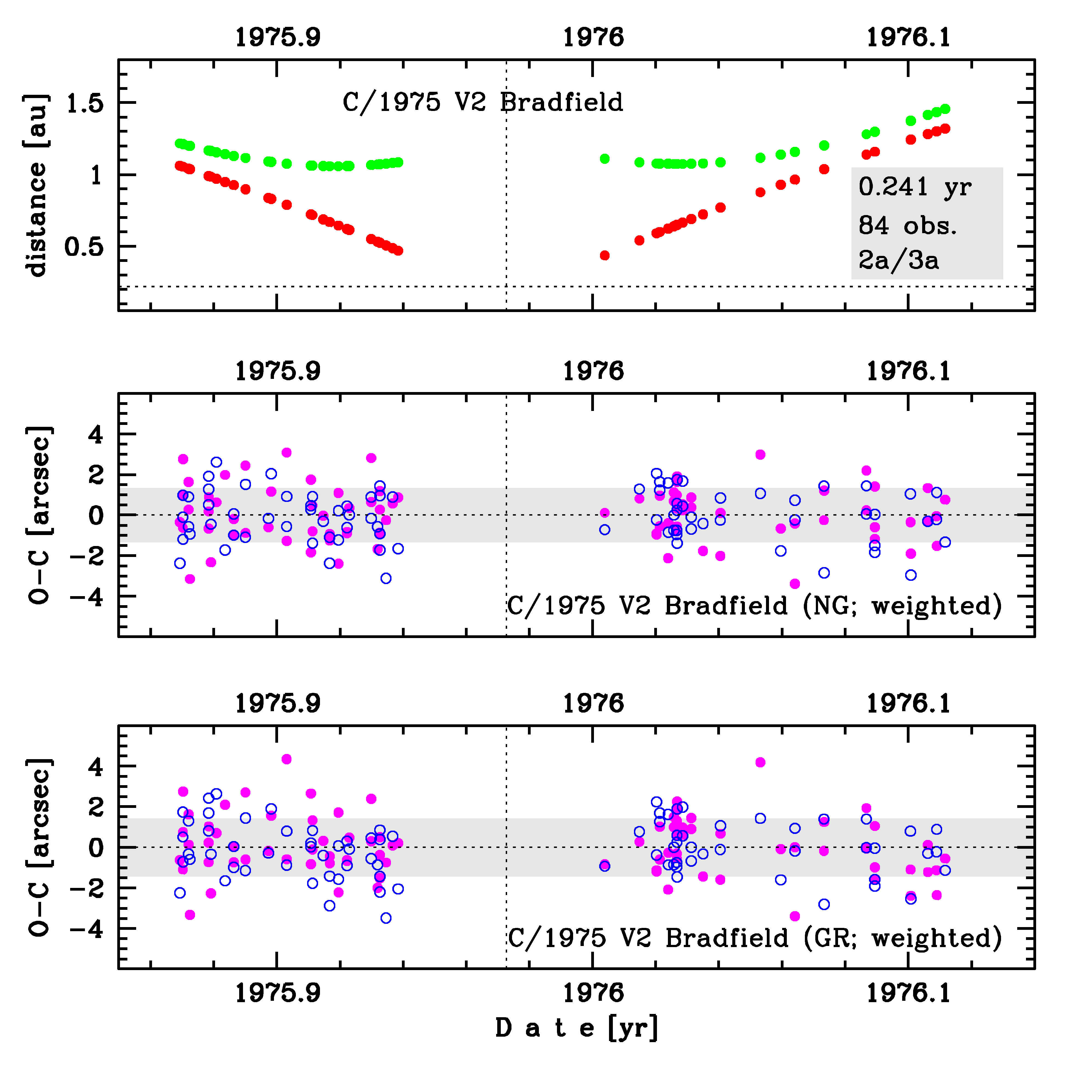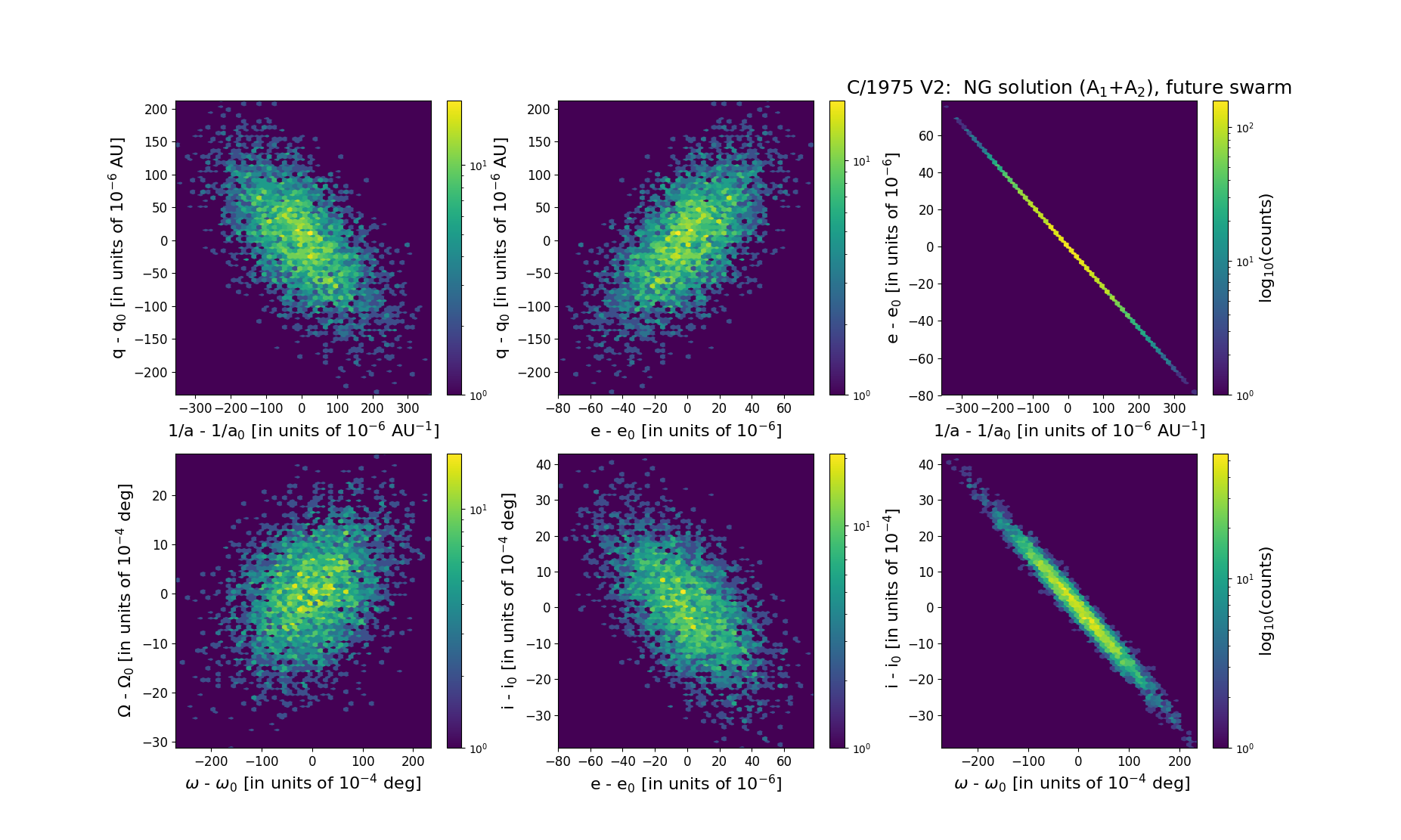C/1975 V2 Bradfield
more info
Comet C/1975 V2 was discovered on 11 November 1975 by William A. Bradfield (Dernancourt, South Australia, Australia), that is about a month and 10 days before its perihelion passage.This comet was observed until mid- February 1976.
Comet had its closest approach to the Earth on 1 December 1975 (1.058 au), almost 3 weeks after discovery and 3 weeks before its perihelion passage. After perihelion passage, it has second close approach to the Earth on 9 January 1976 (1.074 au).
Solutions given here are based on data spanning over 0.241 yr in a range of heliocentric distances: 1.06 au – 0.219 au (perihelion) – 1.32 au. Despite a very short arc of data, nongravitational orbits can be determined and results on decresing of RMS from 1.43 to 1.33 arcsec; however NG orbits are very poor quality and uncertainties of NG parameters are relatively large.
Both NG orbits suggest that this is neither Oort spike comet nor interstellar comet.
All solutions given here show that this comet suffers rather large planetary perturbations during its passage through the planetary system, and these perturbations lead to a more tight future orbit with semimajor axis of about 1,000 au.
See also Królikowska 2020.
Comet had its closest approach to the Earth on 1 December 1975 (1.058 au), almost 3 weeks after discovery and 3 weeks before its perihelion passage. After perihelion passage, it has second close approach to the Earth on 9 January 1976 (1.074 au).
Solutions given here are based on data spanning over 0.241 yr in a range of heliocentric distances: 1.06 au – 0.219 au (perihelion) – 1.32 au. Despite a very short arc of data, nongravitational orbits can be determined and results on decresing of RMS from 1.43 to 1.33 arcsec; however NG orbits are very poor quality and uncertainties of NG parameters are relatively large.
Both NG orbits suggest that this is neither Oort spike comet nor interstellar comet.
All solutions given here show that this comet suffers rather large planetary perturbations during its passage through the planetary system, and these perturbations lead to a more tight future orbit with semimajor axis of about 1,000 au.
See also Królikowska 2020.
| solution description | ||
|---|---|---|
| number of observations | 84 | |
| data interval | 1975 11 13 – 1976 02 09 | |
| data type | perihelion within the observation arc (FULL) | |
| data arc selection | entire data set (STD) | |
| range of heliocentric distances | 1.06 au – 0.22 au (perihelion) – 1.32 au | |
| type of model of motion | NS - non-gravitational orbits for standard g(r) | |
| data weighting | YES | |
| number of residuals | 167 | |
| RMS [arcseconds] | 1.33 | |
| orbit quality class | 3a | |
| orbital elements (barycentric ecliptic J2000) | ||
|---|---|---|
| Epoch | 2283 08 01 | |
| perihelion date | 1975 12 20.96682698 | ± 0.00302302 |
| perihelion distance [au] | 0.21987034 | ± 0.00006637 |
| eccentricity | 0.99980005 | ± 0.00002325 |
| argument of perihelion [°] | 358.149697 | ± 0.007405 |
| ascending node [°] | 271.124409 | ± 0.000856 |
| inclination [°] | 70.995052 | ± 0.001205 |
| reciprocal semi-major axis [10-6 au-1] | 909.40 | ± 105.89 |
| file containing 5001 VCs swarm |
|---|
| 1975v2n5.bpl |

Upper panel: Time distribution of positional observations with corresponding heliocentric (red curve) and geocentric (green curve) distance at which they were taken. The horizontal dotted line shows the perihelion distance for a given comet whereas vertical dotted line — the moment of perihelion passage.
Lower panel (panels): O-C diagram for this(two) solution (solutions) given in this database, where residuals in right ascension are shown using magenta dots and in declination by blue open circles.
Lower panel (panels): O-C diagram for this(two) solution (solutions) given in this database, where residuals in right ascension are shown using magenta dots and in declination by blue open circles.
